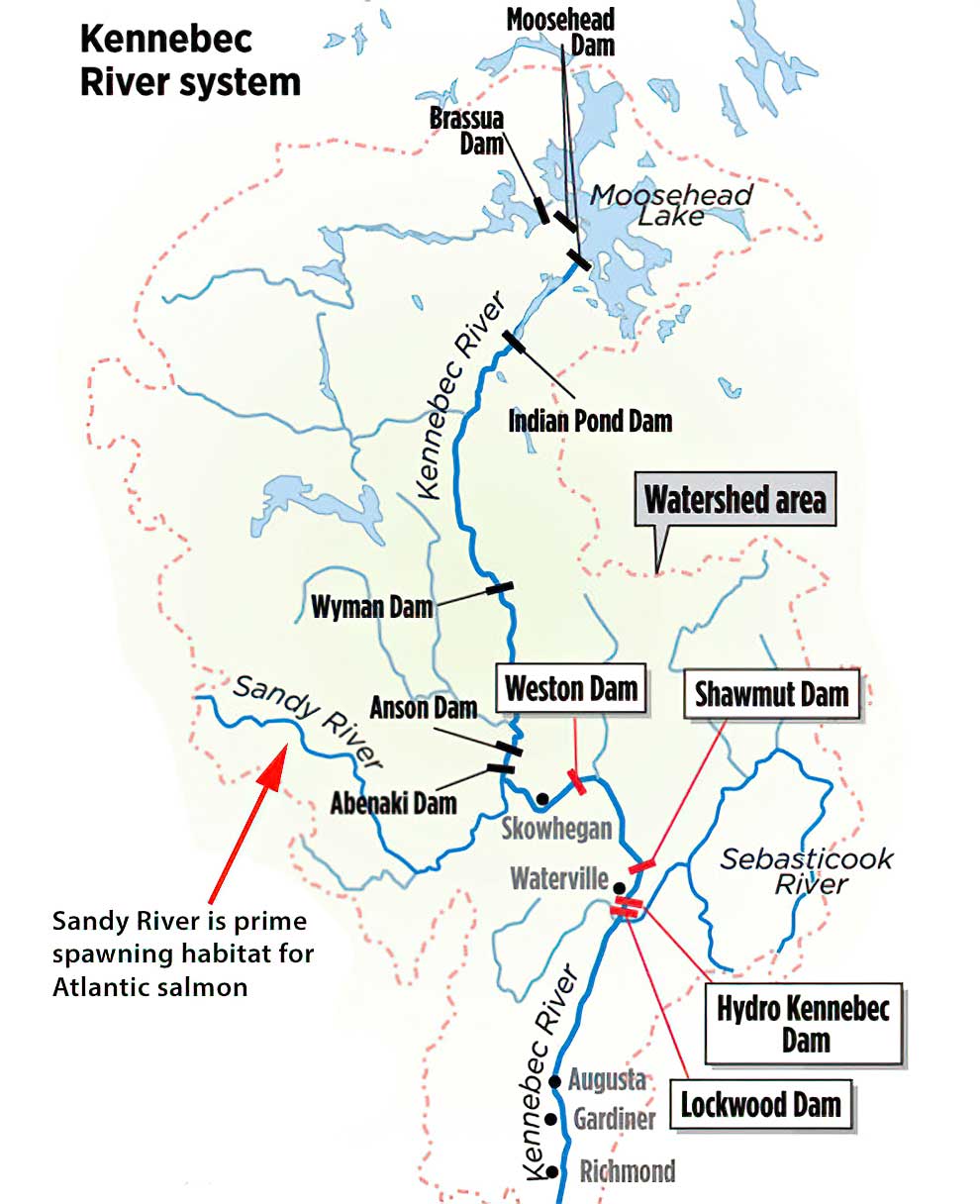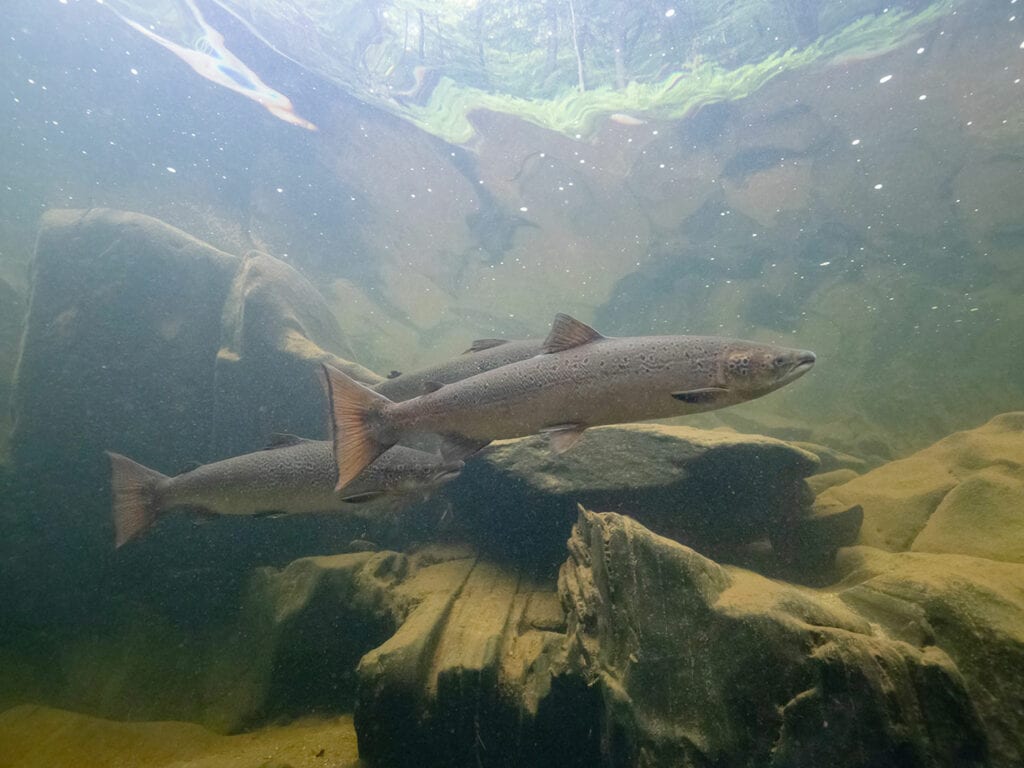Reunite the Kennebec!
The Federal Energy Regulatory Commission (FERC) is currently conducting a critical dam relicensing and license amendment process for the Kennebec River dams.
We should seize this opportunity to provide future generations with a vibrant river that will support thriving fisheries, create new recreational opportunities, and promote economic development in riverfront communities.
The Kennebec River experienced a dramatic resurgence in sea-run fish populations, wildlife, and economic opportunity with the removal of the Edwards Dam in 1999. Now it’s time to continue this success by reconnecting Atlantic salmon and other sea-run fish to the Sandy River.
Maine’s Legacy of Bringing Rivers Back to Life — A Win-Win for Wildlife, Outdoor Recreation, and the Economy
In Maine, we know from experience that when we remove obsolete dams, native fish and wildlife return in record numbers, injecting new life into rivers that helps revive riverfront communities and supports commercial and recreational fisheries.
The removal of the Edwards Dam in Augusta has been one of the nation’s biggest environmental success stories, with millions of river herring returning annually, along with shad, sturgeon, and other species. Communities along this section of the river have experienced major benefits, including revitalization of downtowns in Augusta and Gardiner.
Supporting healthy rivers also respects the Wabanaki people who have close connections to all of Maine’s major waterways and the species these rivers support.
Restoring access to the Sandy River will give endangered Atlantic salmon a chance to survive and help bring back millions of American shad, American eel, and river herring. These fish species support Maine’s iconic commercial fishing industries.
This moment is our best chance to shape the future of the Kennebec.
It is impossible to save Atlantic salmon from extinction and see meaningful restoration of river herring, shad, and other sea-run fish in the Kennebec River above Waterville without major changes at the four lower Kennebec River dams. We need to work together on a solution that works for the river, for the fish, and for local people and businesses.
Reuniting the Kennebec Restores the Entire Gulf of Maine Ecosystem
The Kennebec was once the most productive river in Maine for sea-run fish, with Atlantic salmon runs in the hundreds of thousands, but now Atlantic salmon are critically endangered. We need to act now to restore a healthy Kennebec.
Atlantic salmon and other sea-run fish species face a gauntlet of four dams between Waterville and Skowhegan that makes it impossible to reach the Sandy River, a tributary of the Kennebec that provides some of the best spawning and rearing habitat in the Northeast. The harm these dams cause far outweighs the benefits from their small energy output.
Four Dams Stand in the Way of Atlantic Salmon and Other Sea-run Fish
Mainers have played a vital role in bringing life back to our rivers because clean water is so central to Maine’s economy and way of life. Removing four obsolete dams on the Kennebec River is an urgent next step that will improve the health of the Gulf of Maine, enhance riverfront communities, and bring back millions of sea-run fish, including endangered Atlantic salmon.
The Kennebec was once the most productive river in Maine,1 supporting Atlantic salmon runs in the hundreds of thousands,2 and runs of shad and river herring in the many millions. Today, the future of the Kennebec River is at a critical point. Atlantic salmon are on the brink of extinction, and their survival depends on further restoration of the Kennebec more than any other river in the United States.
Four dams above Waterville, owned by the international energy giant Brookfield Renewable Partners, stand in the way of a free and healthy Kennebec, blocking access to many miles of historic spawning and rearing habitat.
Federal and state agencies have identified these dams as the key impediment to restoring the Kennebec and have called for significant action: the removal of the Shawmut Dam and potentially others in order to save endangered Atlantic salmon and other sea-run fish.
News
- Op-ed in the New York Times: "Let the Salmon Run Free," by Dr. John Waldman, author of Running Silver: Restoring Atlantic Rivers and Their Great Fish Migrations
- Perspective: "Sturgeon's Return Show Power of River Restoration Work," by Patricia Hart
- News release: Fight to Prevent Extinction of Atlantic Salmon Moves to FERC Relicensing Process
- News release: Conservationists Call on Brookfield to Protect Salmon as Spring Migration Begins
- Perspective: "The Kennebec River belongs to all Mainers, not just Brookfield," by Sean McCormick
- Perspective: "Kennebec River Dam Debate Hijacked by Red Herring," by George Lapointe
- Perspective: “Our Rivers Should Be Alive and Productive. Brookfield is Not Helping,” by Richard Lawrence
- News release: Brookfield Sued for Repeatedly Breaking the Law and Killing Endangered Atlantic Salmon
- News release: “Mainers Call for Removal of Dams to Restore a Healthy Kennebec and Save Salmon”
- Blog: “Fatal Flaws in Brookfield’s Proposal for the Kennebec”
- Perspective: “Restoring the Kennebec, the Nucleus of Wabanaki Life,” by Mali Obomsawin
- Perspective: “Enough of ‘pickerel vs. payroll’ on Kennebec,” by Willie Grenier
- Video: “Saving Atlantic Salmon on the Kennebec” (pre-recorded webinar)
- Letter: Patagonia letter to US Commerce Secretary urging Kennebec dam removal
Dam Removal Brings Rivers Back to Life
In Maine, we know from experience that when we remove dams, native fish and wildlife return in record numbers, injecting new life into rivers that helps revive riverfront communities and supports commercial and recreational fisheries.
Dam removals on the Penobscot River in the mid-2000s have boosted fishing3 and paddling.4
After the removal of the Edwards Dam in 1999 and the Fort Halifax Dam on the Sebasticook River in 2008, the lower Kennebec River has surged back to life:
- The run of river herring is the largest in North America, exceeding three million fish annually. Since 2009, 36 million alewives have reached habitat beyond Benton Falls.
- A large riverfront park and access to a free-flowing river has helped spur an economic revival in Augusta’s downtown.
- The river supports good recreational fisheries for shad5 and commercial fisheries for alewife and blueback herring.6
- The largest concentrations of Bald Eagles on the East Coast flocks to the Sebasticook River.
Four Dams Stand in the Way of Salmon Recovery
The Sandy River and its tributaries in interior Maine provide some of the best spawning and rearing habitat for Atlantic salmon and other sea-run fish, but these fish cannot reach it because Brookfield’s four dams above Waterville block their passage.
Brookfield’s Four Dams (see & zoom in on map below)
- Lockwood Dam in Waterville
- Hydro-Kennebec Dam also in Waterville
- Shawmut Dam in Fairfield
- Weston Dam in Skowhegan

In 1998, the Kennebec Coalition7 signed a legal agreement with the owners of these dams that was supposed to result in rapid restoration of fish species in the Kennebec. Twenty-two years later, sea-run fish still cannot swim above the Lockwood Dam because Brookfield and previous dam owners have utterly failed to live up to their responsibilities.
State and Federal Agencies Call for Dam Removal on Kennebec
Recent filings by state and federal agencies show that the tide is turning against Brookfield and in favor of native fish and a rejuvenated river above Waterville:
- At the beginning of 2020, Brookfield applied for a new license for its Shawmut Dam, the third dam up from Waterville. The Maine Department of Marine Resources (DMR) and National Marine Fisheries Services (NMFS) both opposed the application and recommended removing the dam.
- In July 2020, the federal government rejected Brookfield’s proposed Species Protection Plan (SPP) for Atlantic salmon.8
Read what state and federal agencies had to say about dam removal in their own words:
“The Shawmut project represents less than 0.1% of the production of electricity in the State of Maine yet, if relicensed with underperforming fishways, would hasten the extinction of an iconic Maine species, Atlantic salmon, and could result in millions of sea-run fish not reaching historic habitats over the term of the license…MDMR believes the Shawmut project is particularly suited for decommissioning and removal."9 (emphasis added) – DMR
“Significant spawning, rearing, and migratory habitat exists above the Shawmut Project. Existing dams prevent access to those historical habitats. Atlantic salmon were virtually extirpated from their historical range within the Kennebec River watershed. Accordingly, a decision to decommission and remove the Shawmut Project and thereby remove a significant barrier to recovering an endangered species, and support the restoration of several anadromous fish, would fulfill the Commission’s mandate under the FPA to ensure the best comprehensive use of a waterway."10 (emphasis added) — NMFS
Brookfield’s Four Dams Provide Little Benefit to Maine
The four dams above Waterville generate an insignificant amount of hydroelectric power, and the damage they do to the Kennebec’s ecosystem far outweighs their limited benefits.
The dams represent only 6%11 of Maine’s overall hydroelectric capacity and are increasingly unnecessary as the state accelerates the transition to solar and wind energy to combat climate change. For example, the growth in solar energy generation is expected to dwarf the capacity provided by the four dams by about five to one in the next five years.12
The Kennebec and Atlantic Salmon Need Help Now
Atlantic salmon will go extinct in the U.S. without safe access to the Sandy River to spawn. Removing Brookfield’s four dams would open up the Kennebec River to its confluence with the Sandy River, helping recover Atlantic salmon and restoring millions more shad and river herring as well.
Healthy sea-run fish populations are critical to the Maine lobster industry, to the countless birds and wildlife that prey on them, and to any hope of restoring coastal ground fish (such as halibut and cod) populations in the Gulf of Maine.
A free-flowing Kennebec River will also support increased recreation opportunities and complement community development along the riverfront.
When fish are once again able to reach their historic spawning grounds above Waterville, a lively and rejuvenated river will inject new energy and life into the region that will benefit Mainers for generations to come.

1 Prescriptions for the Shawmut Project (P-2322-069). August 28. P.1. Accessible at https://onedrive.live.com/?authkey=%21AG5kgboDmX2md3w&id=951ACB1D108AE542%212384&cid=951ACB1D108AE542.
2 2006. Saunders et al. Maine’s Diadromous Fish Community: Past, Present, and Implications for Atlantic Salmon Recovery. Fisheries 31(11):537-547. Table 2. Accessible at https://onedrive.live.com/?authkey=%21AG5kgboDmX2md3w&id=951ACB1D108AE542%212384&cid=951ACB1D108AE542
3 2020. John Holyoke. Bangor Daily News. Fish are thriving in the Penobscot as shad returns shatter record. June 19. Accessed at https://www.bangordailynews.com/2020/06/19/outdoors/penobscot-shad-returns-shatter-record/.
4 2014. Butch Phillips. Bangor Daily News. Celebrating the canoe race on a free-flowing Penobscot River I’ve waited all my life to see. August 15. Accessed at: https://www.bangordailynews.com/2014/08/15/opinion/celebrating-the-canoe-race-on-a-free-flowing-penobscot-river-ive-waited-all-my-life-to-see/.
5 2020. John Holyoke. Bangor Daily News. How you can catch 20 fish in just a few hours. May 28. Accessed at: https://www.bangordailynews.com/2020/05/28/outdoors/heres-how-you-can-catch-20-american-shad-in-just-a-few-hours/.
6 2020. Molly Shelly. Morning Sentinel. Millions of alewives running the Sebasticook River, scaling Benton Falls Dam ladder. May 4, updated May 25. https://www.centralmaine.com/2020/05/04/millions-of-alewives-running-the-sebasticook-river-scaling-benton-falls-dam-ladder/.
7 The Kennebec Coalition consists of the Atlantic Salmon Federation, Maine Rivers, the Natural Resources Council of Maine, and Trout Unlimited and its Kennebec Valley chapter. All of the groups except Maine Rivers are signatories to the 1998 agreement.
8 2020. FERC. Rejection of Species Protection Plan. July 13. Accessible at https://onedrive.live.com/?authkey=%21AG5kgboDmX2md3w&id=951ACB1D108AE542%212384&cid=951ACB1D108AE542
9 2020. DMR, Op. Cit., Page 3. Accessible at https://onedrive.live.com/?authkey=%21AG5kgboDmX2md3w&id=951ACB1D108AE542%212384&cid=951ACB1D108AE542
10 2020. NMFS. Comments, Recommendations, Preliminary terms and Conditions, and Preliminary Fishway Prescriptions for the Shawmut Hydroelectric Project (FERC No. 2322). August 28. Pp. 43-44. Accessible at https://onedrive.live.com/?authkey=%21AG5kgboDmX2md3w&id=951ACB1D108AE542%212384&cid=951ACB1D108AE542
11 Kleinschmidt Associates. 2015. Maine Hydropower Study. Prepared for Maine Governor’s Energy Office. Tables 1-1 and 2-1. Accessed at https://www.maine.gov/energy/publications_information/001%20ME%20GEO%20Rpt%2002-04-15.pdf.
12 Maine’s solar generation capacity is expected to grow by an additional 1,128 MW over the next 5 years according to the Solar Energy Industries Association. Accessed at https://www.seia.org/state-solar-policy/maine-solar
Banner photo: Looking upstream on the Kennebec RIver, from above the Shawmut Dam in Fairfield, Maine. Photo by J.Monkman/NRCM










